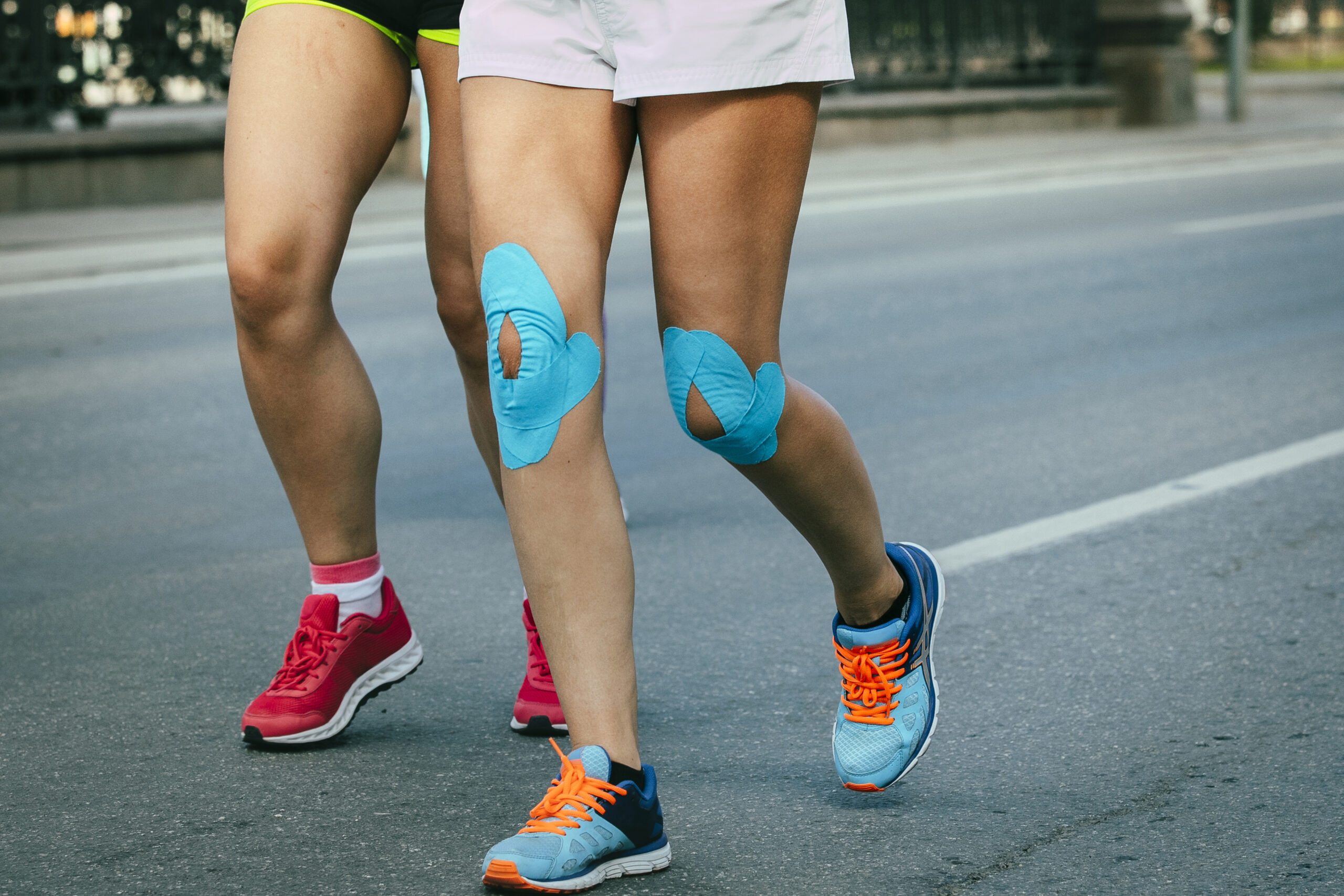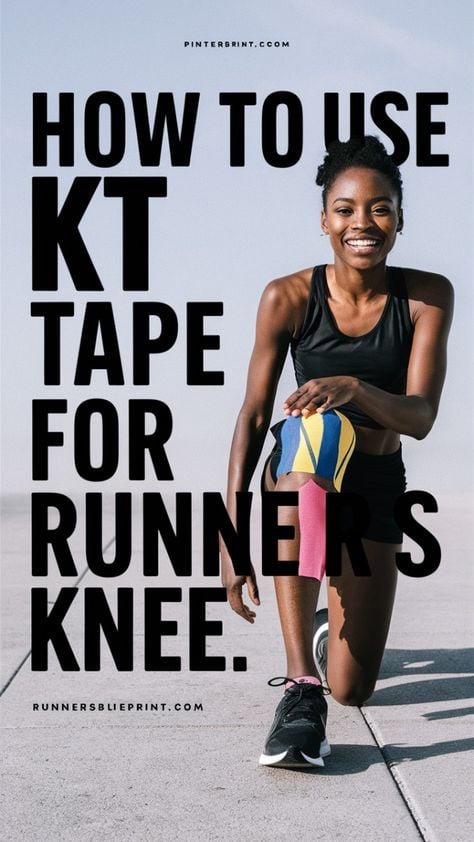I get it.
Knee pain is one of the most frustrating things about running.
That annoying kneecap pain that flares up when you run? I know it all too well
As a coach and fellow runner, I’ve seen many athletes—including myself—struggle with the notorious runner’s knee. It strikes often, catching both newbies and seasoned marathoners off guard.
When that familiar ache in your knee starts creeping in, you’ll search for quick, effective relief.
I’ve personally found KT tape incredibly helpful, and I highly recommend it. This isn’t just any tape; it’s designed to lift your skin slightly, which helps reduce pressure on the knee, improve circulation, and support those tender areas without restricting movement.
If you’re new to kinesiology tape, don’t worry—I’ve got you covered. In this guide, I’ll explain exactly what runner’s knee is, how KT tape can help, and how to apply it properly for maximum relief.
What Is Runner’s Knee?
Before we get into the taping part, let’s break down what a runner’s knee is.
Runner’s knee (also known as chondromalacia patella) is usually caused by overuse of your kneecap.. The symptoms are familiar to many runners: swelling, discomfort, and clicking around the kneecap, especially during weight-bearing activities. If left untreated, the pain can become stabbing and even radiate down to your lower leg.
Poor knee alignment, muscle imbalances, and faulty running mechanics all contribute to this condition. For more on this notorious overuse injury, check out my complete runners knee guide.
What Is Kinesiology Tape?
KT tape is a stretchy, elastic material that supports recovery while still allowing your body to move freely.
Designed to mimic skin’s elasticity, KT tape supports muscles and joints without holding back your range of motion.
When I tried KT tape for the first time, I was surprised at how light it felt—like a second skin, but still offering solid support
Developed by Dr. Kenzo Kase in the 1970s, kinesiology tape has been around for decades but has recently gained popularity among athletes.
It’s not just for runners—it was originally used to help patients with joint alignment and recovery.

How Does KT Tape Help?
So, why use KT tape for patellofemoral pain?
Let me explain briefly.
The tape gently lifts the skin, creating space between the skin and the tissue underneath. This slight lift boosts circulation, reduces swelling, and eases pressure.
KT tape may also alter how your body senses pain by reducing pressure and improving body awareness
In my experience, KT tape offers extra compression, making a noticeable difference during long runs or while recovering
When I tape my knee before a run, I feel more stable and notice less soreness afterward. That’s just my anecdotal evidence, but it doesn’t hurt to try something new—especially if you’re in pain.
Does Kinesiology Tape Really Work? Here’s What the Research Says
Let’s face it—it’s tempting to try something new, especially when you see other runners swearing by it.
But does KT tape actually work for knee pain? Research offers some promising insights:
- Temporary Pain Relief and Support: Studies have shown that kinesiology tape can help reduce pain and improve knee function in people with patellofemoral pain syndrome . For example, a study found that KT tape helped participants experience short-term pain relief and improved muscle activation around the knee.
- Improved Circulation and Swelling Reduction: Kinesiology tape’s lifting effect is believed to promote circulation, which can reduce swelling and aid recovery. According to research published in Physiotherapy Research International, KT tape can improve blood flow in the taped area, which may contribute to reduced inflammation and faster recovery after intense activity.
- Enhanced Muscle Function: Some runners find that KT tape provides additional stability to the muscles surrounding their knee. A review in the Journal of Sports Rehabilitation concluded that KT tape may positively impact muscle activation, helping runners maintain better form and control during movement (source).
A Word of Caution – Though KT tape can be incredibly helpful, applying it incorrectly can worsen your problem. Make sure to follow proper techniques and, if possible, consult with a physical therapist before making taping a regular part of your routine. Patellofemoral pain is an injury that shouldn’t be taken lightly, and taping should never replace a full recovery plan.
How To Apply KT Tape for Runners Knee
Before you start taping, make sure you have all the supplies at hand. These include:
- Tape
- Scissors
- Low allergy or elastic tape
- Pre-wrap
- Clean knee
All of this helps ensure the adhesive tape sticks properly.
Remember that some kinesiology tape products come precut, so just choose the right size for your leg, and that’s all.
Once you have everything you need, follow these steps to do it right.
Patella Taping Method
Patella taping employs rigid tape to help correct the alignment of the kneecap.
Follow this YouTube tutorial to do it right:
- Start by measuring the bump under your patella—or what’s known as the tibial tubercle—to your quadriceps tendon.
- Cut two KT tape strips of similar length. Minimize peeling by rounding the ends.
- Place the low allergy tape over the front of the affected knee to act as an anchor and protect the skin.
- Take a piece of rigid tape, then place it towards the top of your patella.
- Add two more pieces of tape.
- Place two strips of KT tape on your quads to form the teardrop shape, and then run them down both sides of the affected knee.
I like to tape my knee before long runs or speed sessions, giving me the needed stability. It can also stay on for a day or two after a run, supporting my knee during recovery.
The Video Tutorial
Sometimes, words aren’t enough to fully capture how to apply KT tape properly. So, let’s walk through the process with visual aids! Below, you’ll find a video and a step-by-step diagram to guide you. Whether you’re new to KT tape or just need a refresher, these resources will make it easy to get it right.
My best advice? Pause the video at each step and apply your tape along with the demo. Take your time to get the placement just right—rushing can lead to mistakes that won’t give you the full benefits of the tape!
When KT Tape Might Not Be the Best Option
KT tape is a fantastic tool, but it’s not a one-size-fits-all solution. Here are some scenarios where it might not be ideal:
- Severe Knee Injuries: For acute injuries like ligament tears or fractures, KT tape won’t provide the support you need. In these cases, a knee brace or more specialized medical care is recommended.
- Inflamed or Irritated Skin: If your skin is sensitive or you’re experiencing any irritation (from previous tape applications or otherwise), it’s best to avoid KT tape until your skin heals. Constant irritation can lead to rashes or even skin breakdown.
- Chronic Knee Pain Without Diagnosis: If you’ve had knee pain for an extended period without improvement, KT tape alone may not address the underlying issue. Chronic pain should ideally be assessed by a healthcare provider who can help you identify the root cause and create a more comprehensive treatment plan.
- Hot and Humid Conditions: KT tape can sometimes lose its adhesive strength in extreme heat or humidity. If you’re running in hot weather, consider using additional adhesive spray or switching to a compression sleeve.
Final Thoughts
KT tape has become one of my go-to tools for managing knee pain. It’s not a miracle cure, but can offer much-needed relief when used correctly. If you’re struggling with knee pain, try kinesiology tape—just make sure to get the technique right and use it with a balanced recovery plan. And as always, listen to your body.
If you have any questions or need further clarification, feel free to leave a comment. I’m happy to help guide you through the process.
Happy running, and take care of those knees!

